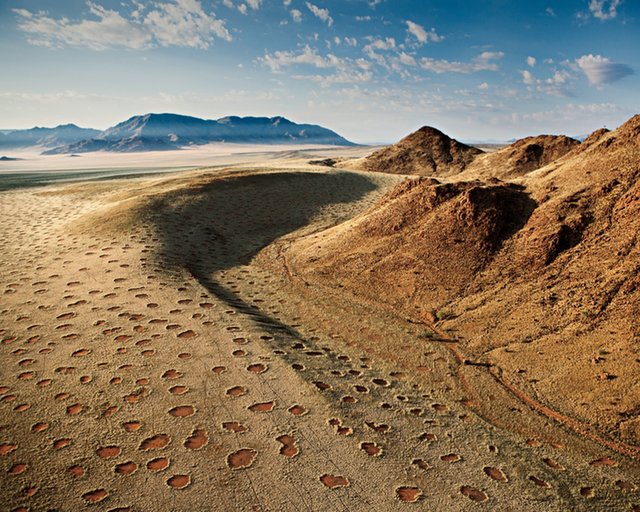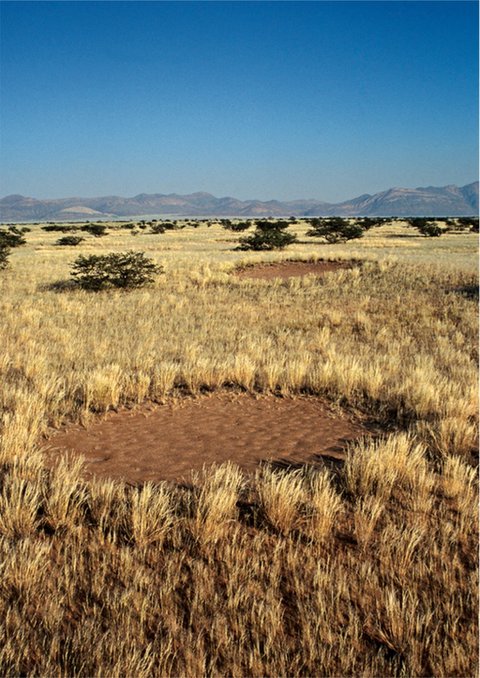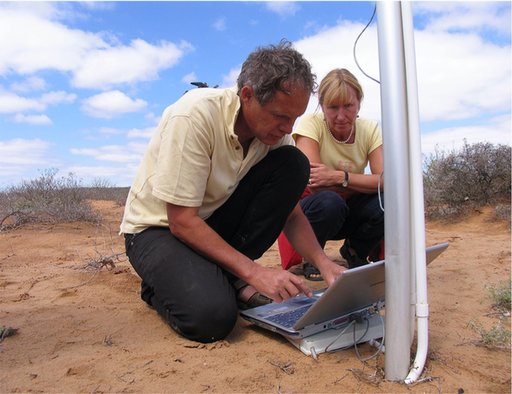
Adragonstirsdeepunderadesert.Itslithersthroughthesandydirt.Itbreathesafiery,poisonousgasasitgoes.Thegasbubblesuptothesurface.There,itburnscirclesofbaredirtinthe grass.
Orsoonestorygoes.Noonehasseenthismythicalbeast.YetsomepeopleinsouthernAfricasayit’sthere.It’showtheyexplainmysteriousdirtcirclesthatdottheeasternedgeoftheNamib Desert.
Thousandsofcirclesstretchasfarastheeyecansee.Somearesmall,justonemeter(threefeet)wide.Othersareaswideas50m(164feet).Thedragonhasbeen busy.
Searching
foraCause
Noteveryonebelievesindragons.Scientistshavelookedforothercausesforthecircles.Somethinkthat,likethemythicaldragon’sfierybreath,agasbubblesup.Othersthinkthatantsmaychewtherootsofthegrasses.Stillothersthinkthattoxicplantsmayspreadtheirpoisons.Anyoftheseactionscouldhavethesameeffect.Theycouldkillthe grasses.
Thesearealltheories,orideas.Theyseempossible.Yet,scientistshavetoproveatheorybeforeit’sacceptedas fact.
Mysteriouscirclesstretchasfarastheeyecan see.


Mysteriouscirclesofbaredirtdotthisdesertonthewestcoastofsouthern Africa.

Africa
Namib
Desert

NorbertJuergensandhiswife,Irmel,collectweatherdataneara circle.
DesertDiscoveries
Onescientistthinkshemayhavesolvedthemystery.BiologistNorbertJuergenshasvisitedthedesert40 times.He’sstudied1,200circles.He’slookedforpatternsamongthecircles,tryingtodiscoverwhattheyhavein common.
Thebiologistsiftedthroughthedirtinsidethecircles.Hetesteditforchemicalsandmeasuredhowmuchwaterwasinit.Herecordedtheanimalshesawinthecircles.Hewrotedownthenamesofplantsgrowing nearby.
CommonClues
Juergensfoundsomesimilaritieswiththecircles.Eachcirclehaddry,sandysoilinitscenter.Healsofoundsomethingsurprising.Eveninthedryseasonwhenitbarelyrains,thegrassesaroundthecirclesstayedalive.Tofindoutwhy,hedugdeepintothesoil.Hediscoveredwetsandundereachcircle.Thegrassrootstappedintothewatertokeepthegrasses alive.
Juergensalsofoundsandtermites.Theytunnelthroughdirtandchewonplantroots.Hestudiedthesecommonclues.Thenhecameupwithhisown theory.

sand termites
MysterySolved?
Juergensthinksthattermiteseatsomegrassroots.Thatkillsthegrassgrowingabovetherootsandformsacircleofbaredirt.Whenitrains,watersoaksintothedirt.It’ssavedinapoolunderthedirt.Thetermitesdrinkthiswater.Thegrassesaroundthecirclesoakitup.It’showtheseinsectsandplantssurviveinthedesertduringthedry season.
Juergenswillhavetostudymorecirclestoproveifhistheoryiscorrect.Whilenotfire-breathingdragons,thesetermitesmayhavecreatedoneofnature’s mysteries.
Aviewfromaboveshows circularpatchesdottingthelandintheNamib Desert.